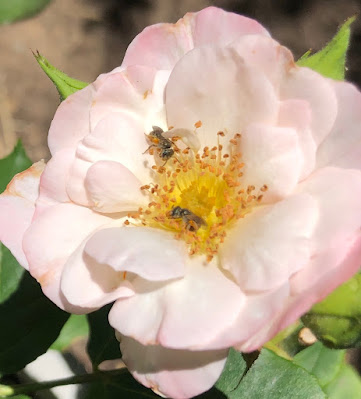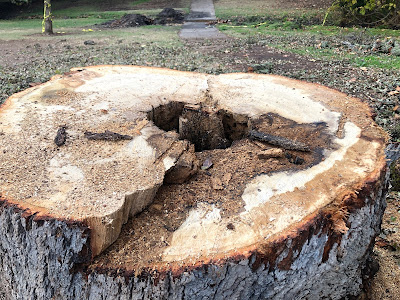
Many native species sleep in the soil

|
|
During spring and summer, sweat bees such
as these can be seen foraging on many
blooming plants. (Photos: Kathy Morrison)
|
Mulch is a wonderful thing, and we have lots of free mulch falling from our trees now. But please don't cover every inch of the garden with it. The native bees we've worked so hard to entice to our plants need some bare soil.
Many California species -- and there are about 1,600 native bee species -- nest underground. Honeybees, which are not native, live in hives, of course. Native carpenter bees do what they're named for: carve holes in fence posts and other wood for their nests.
But other bees are solitary. Smaller than honeybees, sometimes tiny, they nest in soil holes barely the width of a pencil lead, usually in flat, sunny spots. Some bee species nest in already-existing cavities or holes.
I was able to see ground-nesting bees up close earlier in the year when I was adding new chip mulch around my rose bushes. Suddenly 5 or 6 little bees appeared, hovering in a rather agitated manner. I scraped back the chips they were flying over and, sure enough, there were little holes in the ground near the base of one bush. I found other tiny holes at the edge of the same planting area, near the driveway. I watched one bee crawl into its hole.
Now I'm more cautious about what I cover up, and am careful to leave some areas uncovered in each planting bed. (Note: Mulch shouldn't come right up against stems or trunks anyway, since that can promote rot.)
Now, leaf mulch or leaf litter does offer protection for bumble bee queens, and butterfly and moth species, as well as that gardener favorite, the lady beetle. So do leave some leaves!
Pollinators may go into hibernation when the weather turns colder, but they don't go away entirely. And we want them back in spring.
(For more on pollinators and winter, check out this excellent post from the Xerces Society.)
A postscript on an oak tree

|
|
This is the remaining stump from the blue oak that
lost its leader branch in late October.
|
Sure enough, it's been cut down to the final few feet of its 4-foot-wide trunk. I peeked at the stump and wasn't surprised to see the center rotted out. We're probably lucky that the branch fell when it did, rather than the entire tree falling down and taking out a lot of the nearby trees and the utility building next to it -- and potentially harming park visitors.
But I will miss this tree.
Comments
0 comments have been posted.Sacramento Digs Gardening to your inbox.
Sites We Like
Garden Checklist for week of April 21
This week there’s plenty to keep gardeners busy. With no rain in the immediate forecast, remember to irrigate any new transplants.
* Weed, weed, weed! Get them before they flower and go to seed.
* April is the last chance to plant citrus trees such as dwarf orange, lemon and kumquat. These trees also look good in landscaping and provide fresh fruit in winter.
* Smell orange blossoms? Feed citrus trees with a low dose of balanced fertilizer (such as 10-10-10) during bloom to help set fruit. Keep an eye out for ants.
* Apply slow-release fertilizer to the lawn.
* Thoroughly clean debris from the bottom of outdoor ponds or fountains.
* Spring brings a flush of rapid growth, and that means your garden is really hungry. Feed shrubs and trees with a slow-release fertilizer. Or mulch with a 1-inch layer of compost.
* Azaleas and camellias looking a little yellow? If leaves are turning yellow between the veins, give them a boost with chelated iron.
* Trim dead flowers but not leaves from spring-flowering bulbs such as daffodils and tulips. Those leaves gather energy to create next year's flowers. Also, give the bulbs a fertilizer boost after bloom.
* Pinch chrysanthemums back to 12 inches for fall flowers. Cut old stems to the ground.
* Mulch around plants to conserve moisture and control weeds.
* From seed, plant beans, beets, cantaloupes, carrots, corn, cucumbers, melons, radishes and squash.
* Plant onion sets.
* In the flower garden, plant seeds for asters, cosmos, celosia, marigolds, salvia, sunflowers and zinnias.
* Transplant petunias, zinnias, geraniums and other summer bloomers.
* Plant perennials and dahlia tubers for summer bloom.
* Mid to late April is about the last chance to plant summer bulbs, such as gladiolus and tuberous begonias.
* Transplant lettuce seedlings. Choose varieties that mature quickly such as loose leaf.